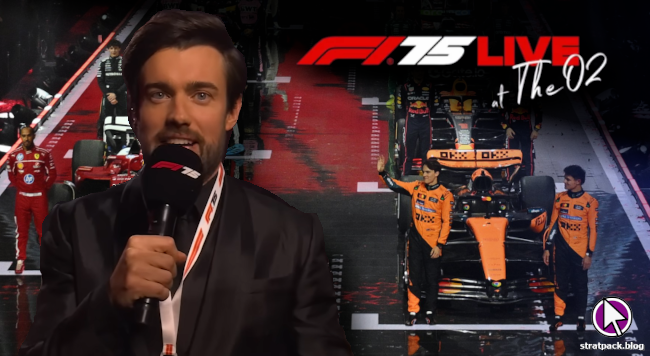
Motorsport Manager review
I’m a little off the pace with Motorsport Manager. Playsport Games’ Formula 1 management game (it’s unlicensed and includes other series, but that’s basically what it is) was first released on mobile in 2014, before moving to PC in 2016. It frequently pops up in Steam sales and Humble Bundles, but despite having a copy sitting in my library for years, it’s only now, a full five years since it came out, that I’ve actually gotten around to playing it.
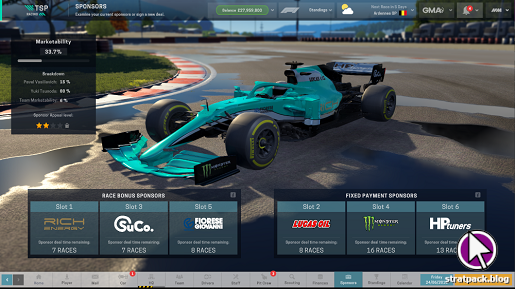
As a big Formula 1 fan, I was both quite excited to get going and somewhat skeptical. Motorsport is about much more than on-track racing, but even the flagship Codemasters F1 series gets the strategic side of things horribly wrong, forcing the player to make suboptimal decisions to ensure the AI stay competitive - especially when the weather changes. Would a small studio fare any better in this area? The answer, as we’ll see in this article, is yes.
In case you’re wondering about the screenshots, there are some great mods out there for this game. The one I’m using is called Formula 1 Manager 2021, and adds all the teams and drivers for the current season, as well as real life media personalities, sponsors, team principals, and even designers and mechanics. Since the game always starts in 2016, this can lead to some funny situations. For example, my team TSP Racing scouted and signed Yuki Tsunoda when he was just 14 years old in-game.
The challenge
You probably don’t need me to tell you how motorsport works, but just in case… Motorsport Manager puts you in the shoes of the team principal of a racing team (existing or new). Said team competes in a series of race weekends over the course of each season, and your job is to try to win races and - ultimately - the drivers’ and constructors’ championships.
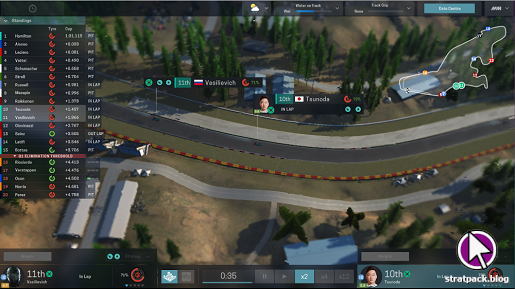
To do this, you must recruit and/or develop the best drivers, design new parts for your cars and improve their performance and reliability, recruit and organise your pit crew, sign up sponsors and keep them happy, and slowly expand your team’s HQ, all while balancing the books, keeping the team owner happy, and making those all-important strategy calls at the track. Basically, think Football Manager but for Formula 1.
The toolset
How do you achieve all this? Off the track, one of your major activities will be developing the car. There are two main ways to do this, and the first is to develop new parts. To make things interesting you must choose from a series of perks and tradeoffs - for example, a certain type of new front wing might make the car better at slow corners, but reduce its reliability. Some parts also employ a creative interpretation of the governing body’s rules, which adds a risk of penalties if discovered during post-race scrutineering. The second way to improve the car is to improve existing parts, asking your team to boost their performance and reliability within set limits.
Your other administrative duties include staff management. Drivers, race mechanics, and designers are all fairly detailed, with various skill ratings and perks - for example, a particular designer might reduce the number of days it takes to develop parts. Then there’s the pit crew, who all have ratings across the different pit stop roles. Your responsibilities here are hiring and firing to improve the quality of the crew, and rotating team members in and out between races, balancing ability with fatigue to reduce the risk of time-consuming mistakes during pit stops that could cost you positions.
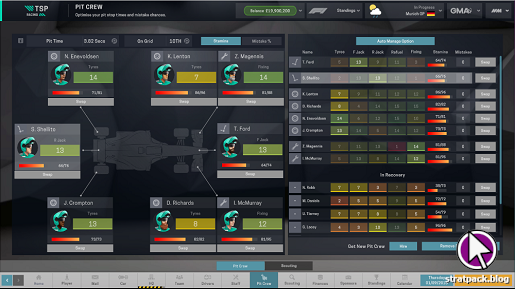
Then there are the commercials. You must balance car development, staff expenditure, HQ development, and other running costs with income. What’s an F1 team’s main revenue source? Sponsorship. Different companies will approach you with offers to slap their logos on your car, each offering varying initial and per-race payments for the privilege. The game here is to consider the money offered against the length of the contracts. If you expect to rapidly improve your team’s standing (and therefore marketability), you might not want to lock a sponsor in on a low-paying multi-year deal.
Of course, the most important part of Motorsport Manager is what happens on track. Your race weekend will begin with a practice session. By running practice programmes, you can earn knowledge perks (Hard Tyres Level 1, Race Trim Level 3, etc.) to equip during later sessions. The other half of this is car setup, where there are three metrics - downforce, handling, and speed balance - that can be indirectly affected by adjusting various parts. You begin with a vague window for each area recommended by the mechanic, and your drivers provide feedback after each stint to narrow this range and allow you to improve the balance ready for the rest of the weekend.
Qualifying and the race are much more about executing and adjusting your strategy as conditions change and events unfold. You’ll go into each session with an idea of how to manage your limited sets of tyres and fuel (you do this by telling your drivers when to change engine modes and drive more or less aggressively). But as in real F1, this can all change at the drop of a hat. Sudden changes to the weather, crashes bringing out the safety car, and component failures can all force you to think quickly about the right next move. The catch with the weather is that unlike real teams, your weather radar only shows conditions a few laps into the future. When you get it wrong it your race can be instantly ruined, but gaining positions by telling your drivers to conserve those softs long enough to switch to inters just as the first drops of rain start to fall is immensely satisfying.
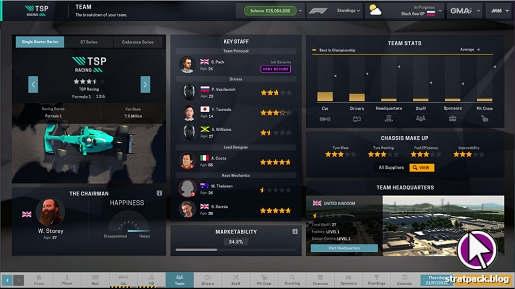
One other interesting mechanic is regular voting on rule changes. You and the other team principals will periodically vote on potential rule changes for the following season, and from time to time the president himself will ask if you’d like to propose a change yourself… for a fee. Proposals include things like longer or shorter sessions, reintroducing refuelling, awarding points for qualifying, and reverse grid races. These all have pros and cons for different teams with different strengths and weaknesses, which makes the vote an interesting political mini-game. The rule modifications themselves are also a nice mechanic for making each season different and preventing your team from becoming too comfortable later in the game.
The difficulty
If you start a new team like I did, you’ll begin at the back of the grid - way at the back. You are a new Haas behind Haas. Your team HQ is a shed, your drivers don’t deserve their seats in the world’s premier motorsport series, and not only are all your car parts low-spec stock components, but they’ll also have terrible reliability, frequently setting back your progress mid-race when you need to spend crucial seconds repairing them during pit stops.
On that note, you better be patient, because in the early game you will lose a lot. For at least the first half of your first season, the only time you’ll finish above 19th is when other drivers crash out. It’s just not possible to gain and retain places in an awful car that adds 30 seconds or more to every pit stop for repairs. This makes it slightly difficult to get into a rhythm with the game initially, but it really makes you appreciate those moments when your strategy propels one of your cars into Q2 or snatches 15th place in a race.
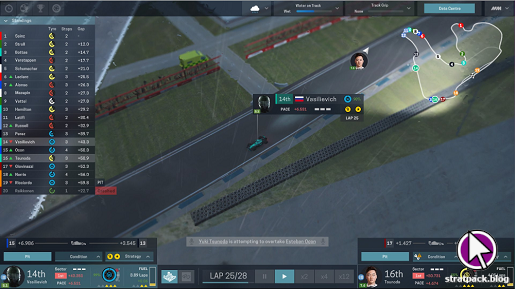
That said, it doesn’t take too long to make some significant improvements to your team. By the latter stages of the first season I was already developing Average parts, had signed Tsunoda, and had a couple of top ten finishes under my belt (albeit in topsy-turvy races). However, modest improvements like these and winning championships are two different matters entirely, so don’t expect to be lifting any silverware in the near future.
In general, you’ll fare better in Motorsport Manager if you watch real life racing. Team management and car development is fairly standard fare for a strategy game, but come race weekend there’s certain knowledge that will really help. What kind of programmes do teams run during practice sessions? Is it better to start the race on hard or soft tyres? Should we pit when the safety car comes out? Although you could work some of this out in-game, knowing what real teams would typically do will serve you well.
Also a note on the AI, which is actually probably the best I’ve seen in a racing game for strategy. It is unphased by rapid weather changes, and it actually outshines the big-budget Codemasters F1 series both in this respect and in terms of strategic variance between AI teams. Opposing strategists also sometimes look rather far ahead on the weather radar - at one point I scoffed when Red Bull put Perez on wets when everyone else was coming off of inters, but a couple of laps later it bucketed it down. Intelligent stuff.
The vibe
All of this adds up to an experience that feels more like a tabletop game based on Formula 1 than a motorsport simulation, but for the most part this is balanced in a way that feels pretty natural. Maybe there are some players who would like to spend hours poring over practice session telemetry in a Football Manager-esque way to construct intricate setups, but representing knowledge gained from practice stints via driver feedback, and perks for the qualifying and race, works well and helps to keep the action moving.
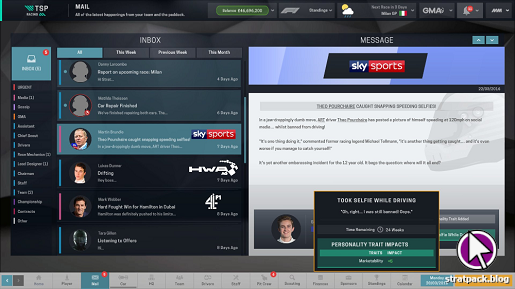
This is not the game for you if you’re hungry for on-track action. Strategy is the name of the game here, and the cars don’t race realistically, instead adopting slot car-like lines when in close proximity. The satisfaction to be gained from Motorsport Manager doesn’t come from the amazing overtaking moves you’d expect in a game like Assetto Corsa, it comes from managing pace, tyres, and part condition over the course of the race to push your drivers as high up the field as possible in the face of changing conditions.
The tone of the game is also greatly improved by the colourful emails, media stories, and social media posts that pop up between sessions and races. This effect is amplified with the F1 2021 mod, and frequently raised a smile when Martin Brundle reported that Wolff and Horner have been at it again, a fan berated Haas’s performances on Twitter, or Jean Todt reprimanded TSP Racing for disgracing the sport by running an illegal rear wing.
The judgement
Motorsport Manager’s complexity and difficulty curve makes it hard to recommend unconditionally. You certainly need to sink a lot of time into the game before you’re familiar enough with the systems to know whether you’re enjoying yourself or not. That said, with the game so often discounted it’s not a massive risk to take, and there’s certainly a lot of love for the little details of Formula 1 here that fans will appreciate regardless.
All in all, I think your enjoyment of Motorport Manager will depend on what type of motorsport fan you are. If you’re part of the new generation of F1 fans that Liberty Media has been courting, one of those who lives for 15-second Instagram videos of crashes and angry radio messages, there’s not much here for you. If you’re what the Super League’s attempted founders would call a “legacy fan”, you’ll likely find great enjoyment in all the intricacies of resource management and stategy on offer.
4/5













